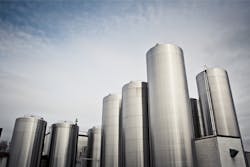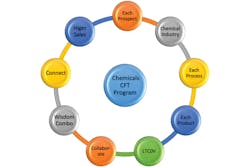The chemical industry is embracing the Industrial Internet of Things (IIoT) and remote operations and management (O&M). Companies such as BASF are able to remotely monitor components such as valves and then use data analytics to improve performance. In the post-digital age, the Industrial Internet of Wisdom (IIoW) will empower IIoT and take us to a new level of performance efficiency. IIoW involves interconnecting the people and knowledge in a way to serve the "4As" knowledge needs: alerts, answers, analysis and advancement.
For a company to determine the service obtainable market (SOM) from the total accessible market (TAM) for each product in each process, there needs to be a continuing quest for the 4As.
Alerts help professionals determine markets and design products for those markets. Resources for 4As, especially alerts, are trade publication feature articles, which routinely provide answers and analysis relative to markets, competitors and product opportunities.
The challenge is to make this information readily available for decision-making. Access to the data needs to be accompanied by extensive, decisive classification to identify what is relevant.
This task of gathering the relevant information should fall on the shoulders of the combust, flow and treat (CFT) suppliers. In fact, they have a big opportunity to convince customers that they have the best product with the lowest cost of ownership. They can justify these claims with proper use of the data.
With proper consultation, suppliers can use the 4As to forecast not only the available market but also the market that should be pursued by the supplier.
Figure 1. Chemicals Combust, Flow and Treat program. All graphics courtesy of the Mcilvaine
The CFT supplier program (see Figure 1) should address each prospect in each industry and each process within that industry where the supplier’s product will have the lowest total cost of ownership (LTCO). Validation of the LTCO (LTCOV) is accomplished with collaboration and a combination of the 4As, which not only present the LTCO but validate it by connecting with the individual purchasers. Trade publication articles can not only be a source of information but can enhance the validation by providing customer connections. This is the route to higher sales.
In the post-digital age with experts analyzing an avalanche of data, it will be possible to determine the total cost of ownership (TCO) for each product in each process in each industry. The supplier can determine where it can validate the LTCO on a Tier 1 basis. Tier 1 is a general validation for most applications. In making a presentation to a specific customer, the supplier should offer a Tier 2 LTCOV, which takes into account variables such as local regulations and electricity cost differences between plants.
To be credible, the LTCOV has to be backed up with papers and analyses, most of which are already available but need to be made accessible from sources such as trade publications. The LTCOV needs to be the product of decision systems with subject matter ultra-expert input. The validation is a continuing process based on changing competitor offerings and industry developments, which can be determined and analyzed through "wisdom of the crowd" (wise crowd) decisions, rather than decisions made by individuals (see Figure 2).
We can leverage the 4As to determine the aggregate of the LTCOV opportunities. This aggregate is the SOM. One innovative analytical tool in the chemical industry is to calculate the CFT opportunities for a specific chemical from manufacture to final use.
Figure 2. The validation is a continuing process based on changing competitor offerings and industry developments.
Figure 3. To pursue the wisdom-based obtainable market (WOM), suppliers need to collaborate with others and conduct multiyear campaigns rather than focus on the sales leads received today.
Pumps, valves and other CFT products used in chlorine manufacturing need to be of a special design incorporating plastic lining or exotic metals. Since the chlorine can be used in a number of downstream processes, it is highly valuable to follow the chlorine use for production of EDC/PVC, isocynates, pulp and paper, organic chemicals, chlorinated intermediates, Cl/C2 aromatics, inorganic chemicals, propylene oxide and water treatment. Some of these applications have the same temperature and corrosion characteristics as the original manufacture. For others (e.g., lower temperature), plastic may be an acceptable substitute. From this analysis, one arrives at the global obtainable market for an exotic metal or lined product.
This production tracking also leads to the size of the obtainable market for each customer. The opportunity depends on the amount of chlorine, but in the case of an isocyanate manufacturer it will depend on similar analyses of other processes within the plant. Wacker Chemie, for example, manufactures chlorine and then uses it multiple times in various downstream processes, all at the same plant.
Suppliers can create right-to-win strategies to take advantage of the potential to expand the wisdom-based obtainable market (WOM) with the help of custom consulting. To pursue this WOM market, suppliers need to collaborate with others and conduct multiyear campaigns rather than focus on the sales leads received today. They need to utilize the feedback from their sales force to improve and tailor their offerings to individual prospects (see Figure 3).
In the post-digital era, CFT suppliers can improve market share by leveraging IIoW. This includes knowledge shared in trade magazines and on websites but also by collaboration with individuals who are contributing to those outlets. Authors fall into a hierarchy of expertise: contributors, subject matter experts and subject matter ultra-experts who are continually taking advantage of IIoW. The challenge for suppliers to best leverage the 4As is substantial but the rewards even more so for those who succeed.




